Complete Solutions to All Questions of chapter ELECTROSTATICS of Class 12 book with complete answers and questions
| Class 12 | PHYSICS |
| Chapter | ELECTROSTATICS |
| D MUKHERJEE | All Questions |
| Number Of Questions | 100 |
| Academic Year | 2023-24 |
A charge q is placed at the centre of the line joining two equal charges Q. The system of the three charges will be in equilibrium if q is equal to:
View SolutionTwo particles , each of mass `m` and carrying charge `Q` , are separated by some distance. If they are in equilibrium under mutual gravitational and electrostatic force then `Q//m (in C//kg)` is of the order of
View SolutionThree point charges are placed at the corner of an equilateral triangle. Assuming only electrostatic forces are acting.
View SolutionCharge `Q` is divided into two parts which are then kept some distance apart . The force between them will be maximum if the two parts are
View SolutionTwo identical positive charges are fixed on the y-axis, at equal distances from the origin O. A particle with a negative charges starts on the x-axis at a large distance from O. moves along the x-axis passes through O, and moves far away from O on the other side. Its acceleration a is taken as positive along its direction of motion. Plot acceleration a of the particle against its x-coordinate.
View SolutionTwo ideantical point charges are placed at a separation of `d`. `P` is a point on the line joining the charges, at a distance `x` from any one charge. The field at `P` is `E, E` is plotted against `x` for value of `x` from close to zero to slightly less then `d`. Which of the following represents the resulting curve
View SolutionTwo identical simple pendulums, `A` and `B` are suspended from the same point. The bobs are given positive charges, with `A` having more charge than `B` making angles `theta_(1)` and `theta_(2)` with the vertical respectively. Which of the following is correct?
View SolutionA point charge `Q` is moved along a ciruclar path around another fixed point charge. The work done is zero
View SolutionIn a regular polygon of `n` sides, each corner is at a distance `r` from the centre. Identical charges of magnitude `Q` are placed at `(n-1)` corners. The field at the centre is
View SolutionA half ring of radius `r` has a linear charge density `lambda`.The potential at the centre of the half ring is
View SolutionTwo identical metals balls with charges `+2Q` and `-Q` are separated by some distance and exert a force `F` on each other . They are joined by a conducting wire , which is then removed. The force between them will now be
View SolutionCharge Q is given a displacement `r=ahati+bhatj` in electric field `E=E_1hati+E_2hatj`. The work done is
View SolutionLet `V_(0)` be the potential at the origin in an electric field `vecE=E_(x)hati+E_(y)hatj`. The potential at the point `(x,y)` is
View SolutionA point charge q moves from point P to pont S along the path PQRS (fig.) in a uniform electric field E pointing parallel to the poistive direction of the X-axis. The coordinates of the points P, Q, R and S are(a, b, O), (2a, O, O)(a, -b,`ulO`) and `(O, O, O) respectively. The work done by the field in the above process is given by the expresison............
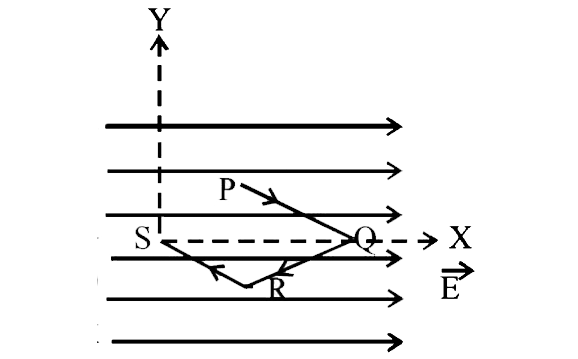
View SolutionThe electric potential V at any point x, y, z (all in meters) in space is given by `V=4x^2` volts. The electric field at the point (1m, 0, 2m) is……………..`V//m`.
View SolutionA non-conducting ring of radius `0.5 m` carries a total charge of `1.11xx10^(-10)`C distributed non-uniformly on its circumference producing an electric field E everywhere is space. The value of the integral `int_(l=oo)^(l=0)-E.dI (l=0` being centre of the ring) in volt is
View SolutionA charge `+q` is fixed at each of the points `x=x_0`, `x=3x_0`, `x=5x_0`,…………`x=oo` on the x axis, and a charge `-q` is fixed at each of the points `x=2x_0`, `x=4x_0`, `x=6x_0`, …………`x=oo`. Here `x_0` is a positive constant. Take the electric potential at a point due to a charge Q at a distance r from it to be `Q//(4piepsilon_0r)`.Then, the potential at the origin due to the above system of
View SolutionA solid sphere of radius `R` is charged uniformly. The electrostatic potential `V` is plotted as a function of distance `r` from the centre of th sphere. Which of the following best represents the resulting curve?
View SolutionA solid sphere of radius R has charge q uniformly distributed over its volume. The distance from it surfce at which the electrostatic potential is equal to half of the potential at the centre is
View SolutionA large solid sphere with uniformly distributed positive charge has a smooth narrow tunnel along its direction. A small particle with negative charge, initially at rest far from the sphere, approaches it along the line of the tunnel, reaches its surface with a speed `v`, and passes through the tunnel. Its speed at the centre of the sphere will be
View SolutionAll charge on a conductor must reside on its outer surface.' This statement is true
View SolutionA point charge `Q` is placed outside a hollow spherical conductor of radius `R` , at a distance `r (r gt R)` from its centre `C` . The field at `C` due to the inducted charges on the conductor is
View SolutionA positive point charge, which is free to move, is placed inside a hollow conducting sphere with negative charge, away from its centre. It will
View SolutionIn a region of space the electric field in the `x`-direction and proportional to `x`i.e., `vec(E )=E_(0)xhat(i)`. Consider an imaginary cubical volume of edge a with its parallel to the axes of coordinates. The charge inside this volume will be
View SolutionA charge `Q`is placed at the mouth of a conical flask. The flux of the electric field through the flask is
View SolutionA long string with a charge of `lambda` per unit length passes through an imaginary cube of edge `a`. The maximum flux of the electric field through the cube will be
View SolutionA spherical conductor `A` of radius `r` is placed concentrically inside a conducting shell `B` of radius `R(R gt r)`. A charge `Q` is given to `A` , and then `A` is joined to `B` by a metal wire. The charge flowing from `A` to `B` will be
View SolutionIn a certain charge distribution, all points having zero potetnial can be joined by a circles `S`. Points inside `S` have positive potential and points outside `S` have negative potential. A positive charg, which is free to move, is placed inside `S`
View SolutionIf the earth's surface is treated as a conducting surface with some charge , then the order of magnitude of the charge per unit area `sigma "in" C//m^(2)` , so that a proton remains suspended in space near the earh's surface will be
View SolutionA simple pendulum of time period `T` is suspended above a large horizontal metal sheet with uniformly distributed positive charge. If the bob is given some negative charge , its time period of oscillation will be
View SolutionA spring - block system undergoes vertical oscillation above a large horizontal metal sheet with uniform positive charge. The time period of the oscillation will be is given a charge `Q` , its time period of oscillation will be
View SolutionA large flat metal surface has a uniform charge density `+sigma`. An electron of mass `m` and charge `u` and returns to it at point `B`. Disregard gravity . The maximum value of `AB` is
View SolutionA and B are two points on the axis and the perpendicular bisector, respectively, of and electric dipole. A and B are far away from the dipole and at equal distance from it. The fields at A and B are `vecE_(A)` and `vecE_(B)`. Then
View SolutionAn electric dipole is placed at the origin `O` and is directed along the `x`-axis. At a point `P`, far away from the dipole, the electric field is parallel to `y`-axis. `OP` makes an angle `theta` with the `x`-axis then
View SolutionAn electric dipole of moment `vecp` is placed in a uniform electric field `vecE`, with `vecp` parallel to `vecE`. It is then rotated by an angle `theta`. The work done is
View SolutionThe radius of the earth is `6400km`, what is its capacitance?
View SolutionWhen two uncharged metal balls of radius `0.09mm` each collide, one electron is transferred between them. The potential difference between them would be
View SolutionA conducting sphere of radius `R` and carrying a charge `Q` is joined to an uncharged conducting sphere of radius `2R`. The charge flowing between them will be
View SolutionIn an isolated parallel plate capacitor of capacitance `C`, the four surfaces have charges `Q_(1),Q_(2),Q_(3)` and `Q_(4)` as shown. The potential difference between the plates is
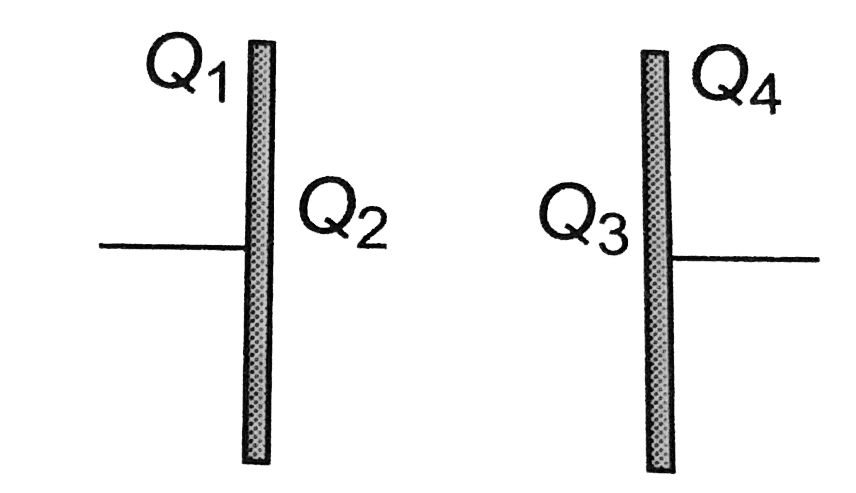
View SolutionA capacitor of capacitance `C` is charged to a potential difference `V` from a cell and then disconnected from it. A charge `+Q` is now given to its positive plate. The potential difference across the capacitor is now.
View SolutionA capacitor is conneted to a cell emf `E` having some internal resistance `r`. The potential difference across the
View SolutionIn a parallel plate capacitor of capacitance `C`, a metal sheet is inserted between the plates, parallel to them. If the thickness of the sheet is half of the separation between the plates. The capacitance will be
View SolutionTwo capacitors of capacitances `3 muF` and `6 muF` are charged to a potential of `12 V` each. They are now connected to each other, with the positive plate of each joined to the negative plate of the other. The potential difference across each will be
View SolutionIn the circuit shown, a potential difference of `60V` is applied acrodd.`AB`. The potential difference between the point `M` and `N` is-
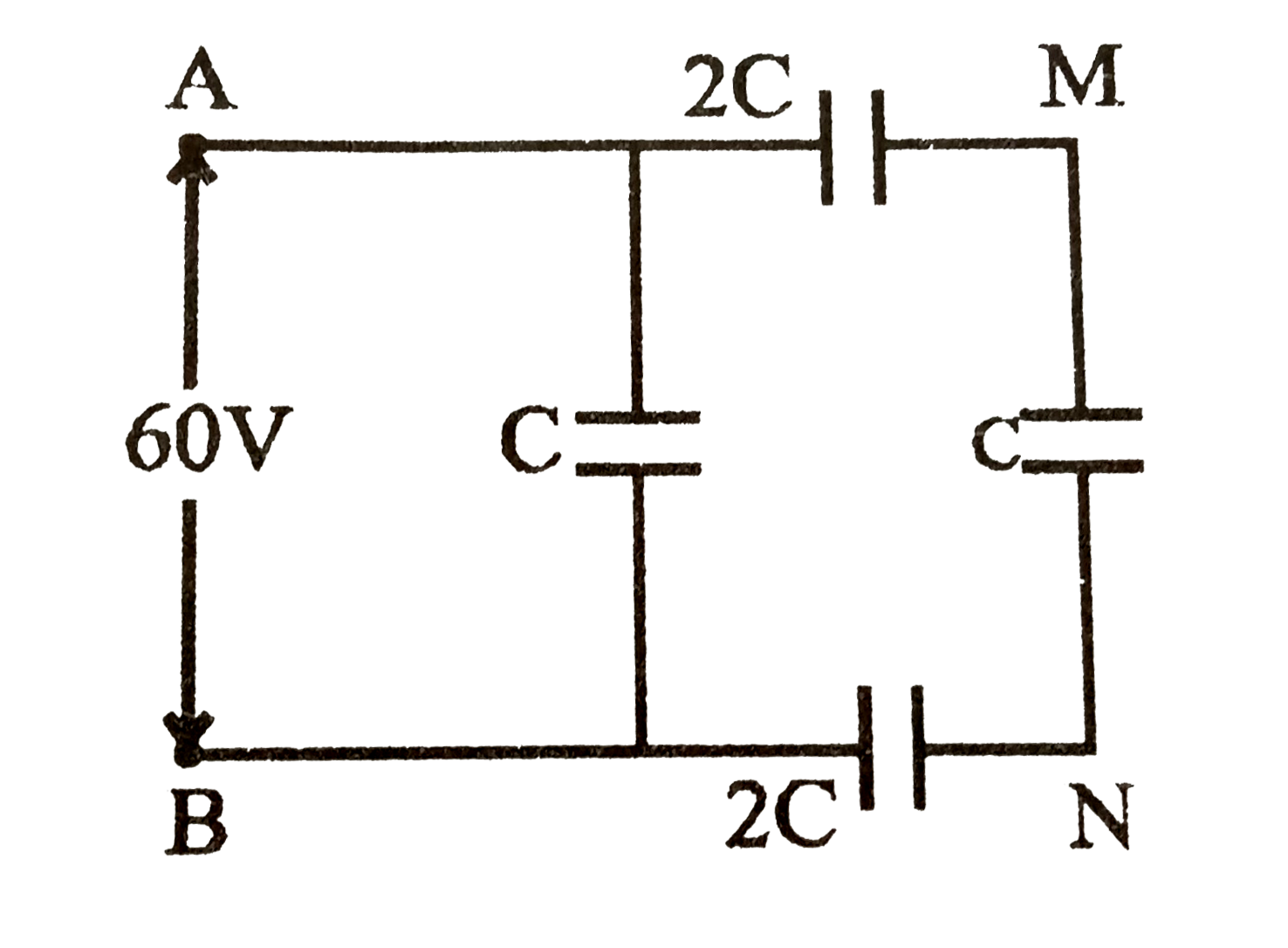
View Solution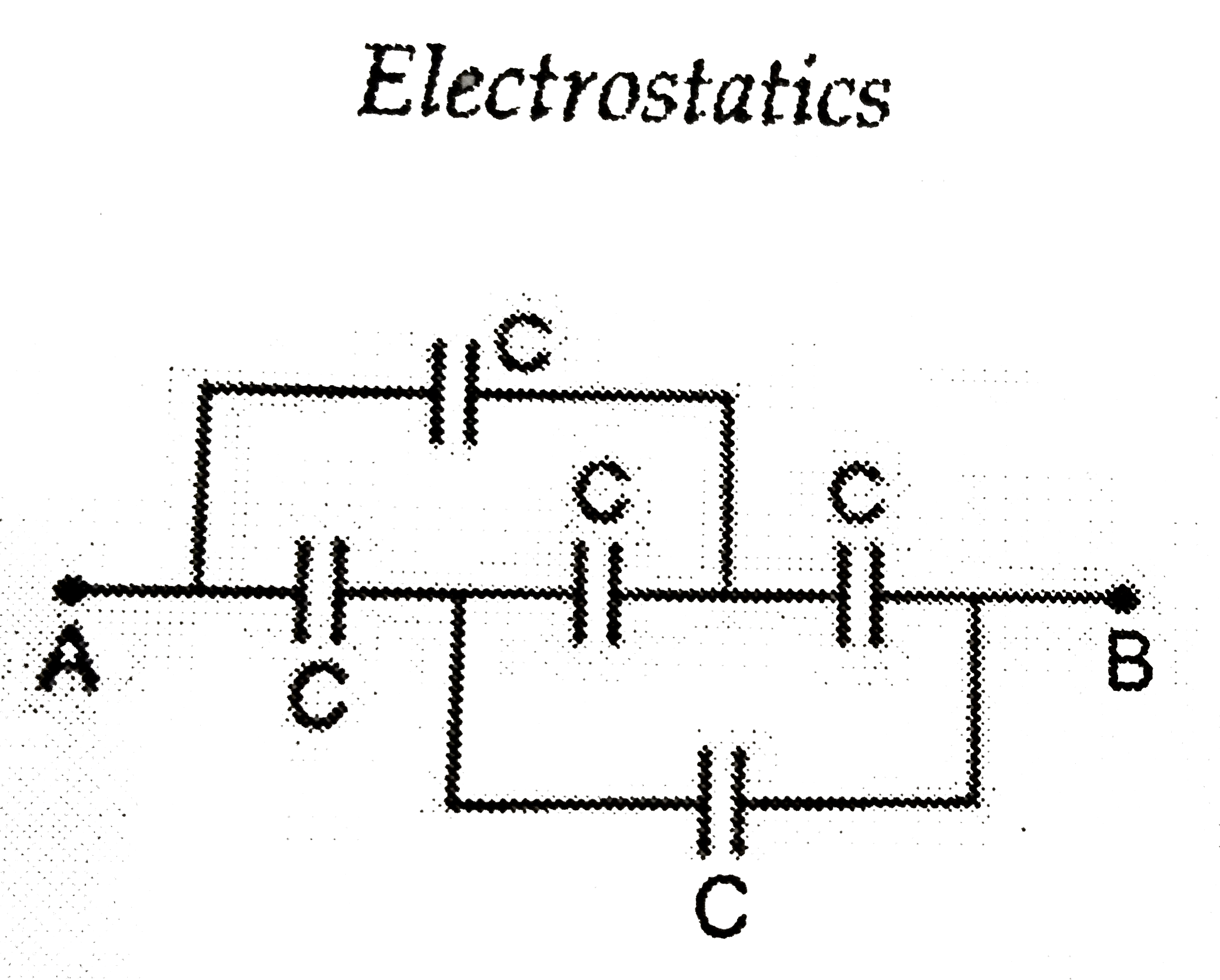
In the circuit shown, the equivalent capacitance between the points `A` and `B` is
View Solution
In the circuit shown, the equivalent capacitance between the points `A` and `B` is
View SolutionIn a parallel-plate capacitor, the region between the plates is filled by a dielectric slab. The capacitor is connected to a cell and the slab is taken out. Then
View SolutionThree charged particle sare in equilibrium under their electrostatic forces only. Then
View SolutionFour identical charges are placed at the points `(1,0,0), (0,1,0),(-1,0,0)`, and `(0,-1,0)`. Then,
View SolutionFour charges , all of the same magnitude , are placed at the four corners of a square . At the centre of the square , the potential is `V` and the field is `E`. By suitable choice of the signs of the four charges ,which of the following can be obtained?
(i) `V = 0 , E = 0`
(ii) `V = 0 , E != 0`
(iii) `V != 0 , E = 0`
(iv) `V != 0 , E != 0`
View SolutionA deuteron and an `alpha`-particle are placed in an electric field.The forces acting on them are `F_(1)` and `F_(2)` and their accelerations are `a_(1)` and `a_(2)` respectively.
(i) `F_(1) = F_(2)`
(ii) `F_(1) != F_(2)`
(iii) `a_(1) = a_(2)`
(iv) `a_(1) != a_(2)`
View SolutionTwo identical charges `+Q` are kept fixed some distance apart.A small particles `P` with charge `q` is placed midway between them . If `P` is given a small displacement `Delta` ,it will undergo simple harmonic motion if
(i) `q` is positive and `Delta` is along the line joining the charges
(ii) `q` is positive and `Delta` is perpendicular to the line joining the charges
(iii) `q` is negative and `Delta` is perpendicular to the line joining the charges
(iv) `q` is positive and `Delta` is along the line joining the charges
View SolutionA ring with a uniform charge `Q` and radius `R`, is placed in the `yz` plane with its centre at the origin
View SolutionA positively charged thin metal ring of radius R is fixed in the xy plane with its centre at the origin O. A negatively charged particle P is released from rest at the point `(0, 0, z_0)` where `z_0gt0`. Then the motion of P is
View SolutionA particle `A` of mass `m` and charge `Q` moves directly towards a fixed particle `B`, which has charge `Q`. The speed of `A` is a `v` when it is far away from `B`. The minimum separtion between the particles is not proportional to
View SolutionThe electric field and the electric potential at a point are E and V respectively.
View SolutionIn a uniform electric field ,
View SolutionCharges `Q_1 and Q_2` lie inside and outside, respectively, of a closed surface S. Let E be the field at any point on S and `phi` be the flux of E over S.
View SolutionCharges `Q_(1)` and `Q_(2)` lie inside and outside respectively of an uncharged conducting shell. Their separation is `r`.
(i) The force on `Q_(1)` is zero
(ii) The force on `Q_(1)` is `k((Q_(1) Q_(2))/(r^(2)))`
(iii) The force on `Q_(2)` is `k((Q_(1) Q_(2))/(r^(2)))`
(iv) The force on `Q_(2)` is zero
View SolutionA spherical conductor `A` lies inside a hollow spherical conductor `B`. Charges `Q_(1)` and `Q_(2)` are given to `A` and `B` respectively (Choose the incorrect option)
View Solution`A,B` and `C` are three concentric metallic shells . Shell `A` is the innermost and shell `C` is the outermost. `A` is given some charge
(i) The inner surfaces of `B`and `C` will have the same charge
(ii) The inner surfaces of `B` and `C` will have the same charge density
(iii) The outer surfaces of `A,B` and `C` will have the same charge
(iv) The outer surfaces of `A,B` and `C` will have the same charge density
View SolutionConsider two large ,identical parallel conducting plates having surface `X` and `Y` .facing each other.The charge per unit area on `X` is `sigma_(1)` and charge per unit surface area of `Y` is `sigma_(2)` .Then,
View Solution`P` i sa point on an equipotential surface `S`. The field at `P` is `E`.
View Solution`S_(1)` and `S_(2)` are two equipotential surfaces on which the potentials are not equal
View SolutionIn a uniform electric field , equipotential surface must
(i) be plane surfaces
(ii) be normal to the direction to the filed
(iii) be spaced such that surfaces having equal difference in potential are separated by equal distances
(iv) have decreasing potentials in the direction of field
View SolutionA metallic solid sphere is placed in a uniform electric fied. The lines of force follow the path(s) shown in Figure as
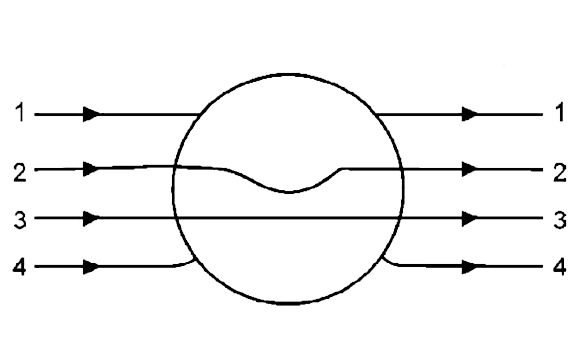
View SolutionThe electric field at a distance `r` from a long wire having charge per unit length `lambda` is
View SolutionTwo points are at distance `a` and `b (a lt b)` from a long string of charge per unit length `lambda`. The potential difference between th epoints is proportional to
View SolutionA charge moves with a speed `v` in a circular path of radius `r` around a long uniformly charged conductor.
View SolutionA simple pendulum of length `l` has a bob of mass `m` , with a charge `q` on it. A vertical sheet of charge , with the vertical . Its time period of oscillation is `T` in this position
(i) `tan theta = (sigma q)/(2 epsilon_(0) mg)`
(ii) `tan theta = (sigma q)/(epsilon_(0) mg)`
(iii) `T lt 2 pi sqrt((l)/(g))`
(iv) `T gt 2pi ((l)/(g))`
View SolutionA dipole of moment `vecp` is placed in a uniform electric field `vecE`. The force on the dipole is `vecF` and the torque is `vec(tau)`
View SolutionAn electric dipole in a uniform electric field experiences (When it is placed at an angle `theta` with the field)
View SolutionTwo large parallel conducting plates are placed close to each other ,the inner surface of the two plates have surface charge densities `+sigma` and `-sigma` .The outer surfaces are without charge.The electric field has a magnitude of
View SolutionTwo large , parallel conducting plates `X` and `Y` , kept close to each other , are given `Q_(1)` and `Q_(2) (Q_(1) gt Q_(2))`. The four surfaces of the plates are `A,B,C` and `D` , as shown
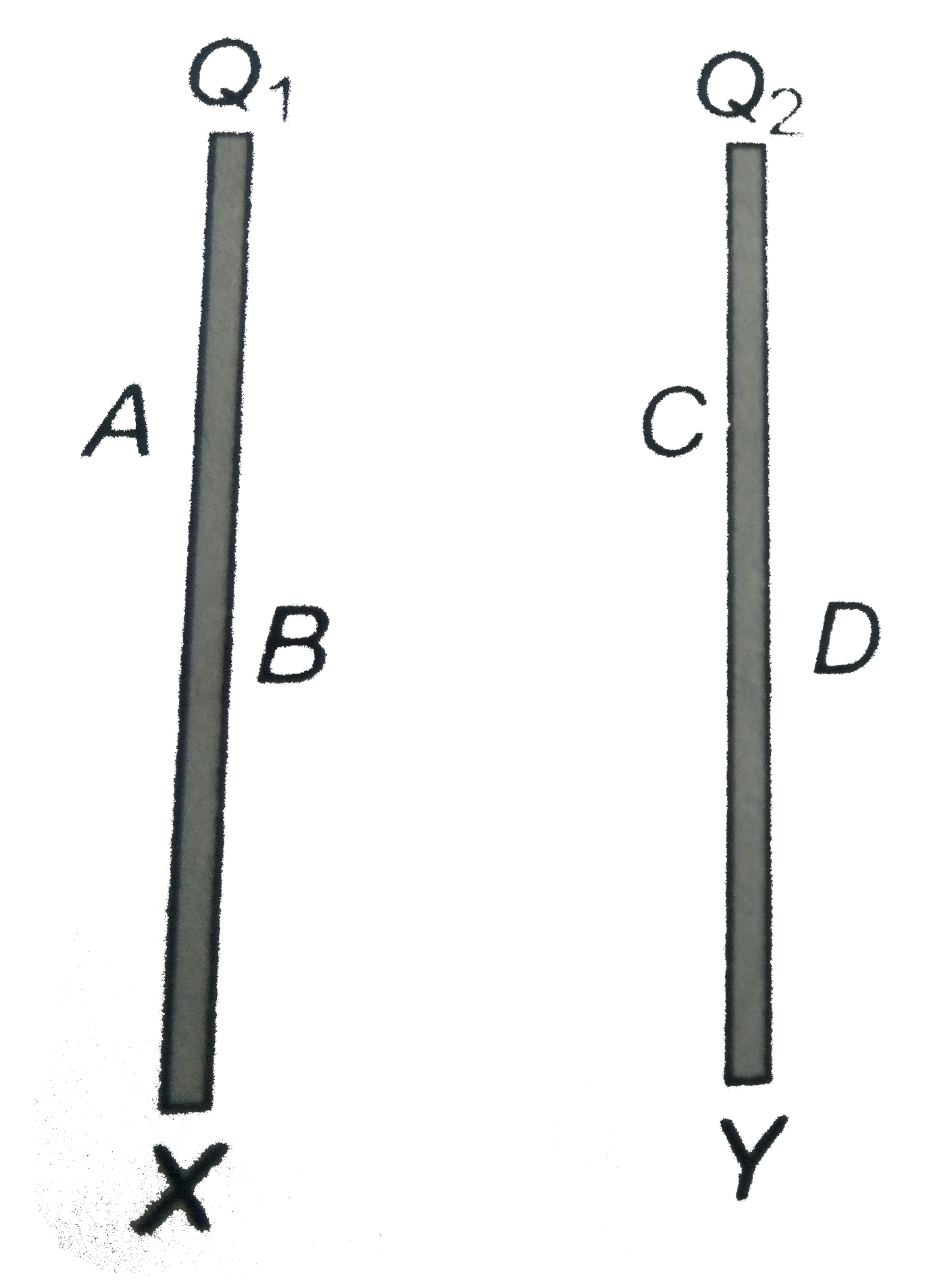
(i) The charge on `A` is `(1)/(2) (Q_(1) + Q_(2))`
(ii) The charge on `B` is `(1)/(2) (Q_(1) - Q_(2))`
(iii) The charge on `C` is `(1)/(2) (Q_(2) - Q_(1))`
(iv) The charge on `D` is `(1)/(2) (Q_(1) + Q_(2))`
View Solution`X` and `Y` are large, parallel conducting plates close to each other. Each face has an area `A`. `X` is given a charge `Q`. `Y` is without any charge. Points `A,B` and `C` are as shown in the figure.
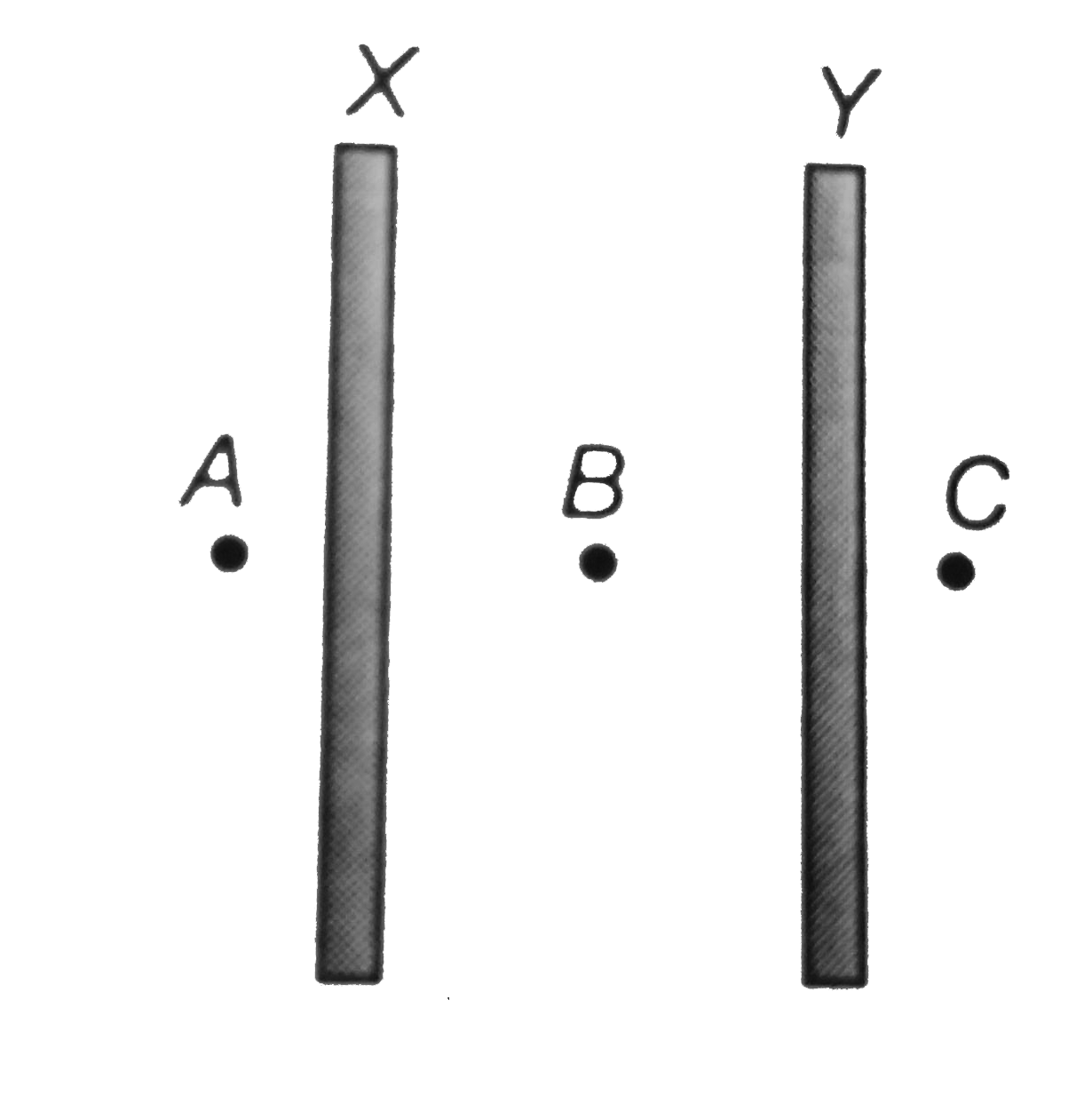
View SolutionA parallel plate capacitor is charged from a cell and then isolated from it. The separation between the plates is now increased
View SolutionWhen a charge of amount Q is given to an isolated metal plate X of surface area A, its surface charge density becomes `sigma_(1)`. When an isolated identical plate Y is brought close to X the surface charge density on X becomes `sigma_(2)`. When Y is earthed the surface charge density on X becomes `sigma_(3)`. Choose the incorrect option.
View SolutionIn an isolated parallel plate capacitor of capacitance `C`, the four surfaces have charges `Q_(1),Q_(2),Q_(3)` and `Q_(4)` as shown. The potential difference between the plates is

View Solution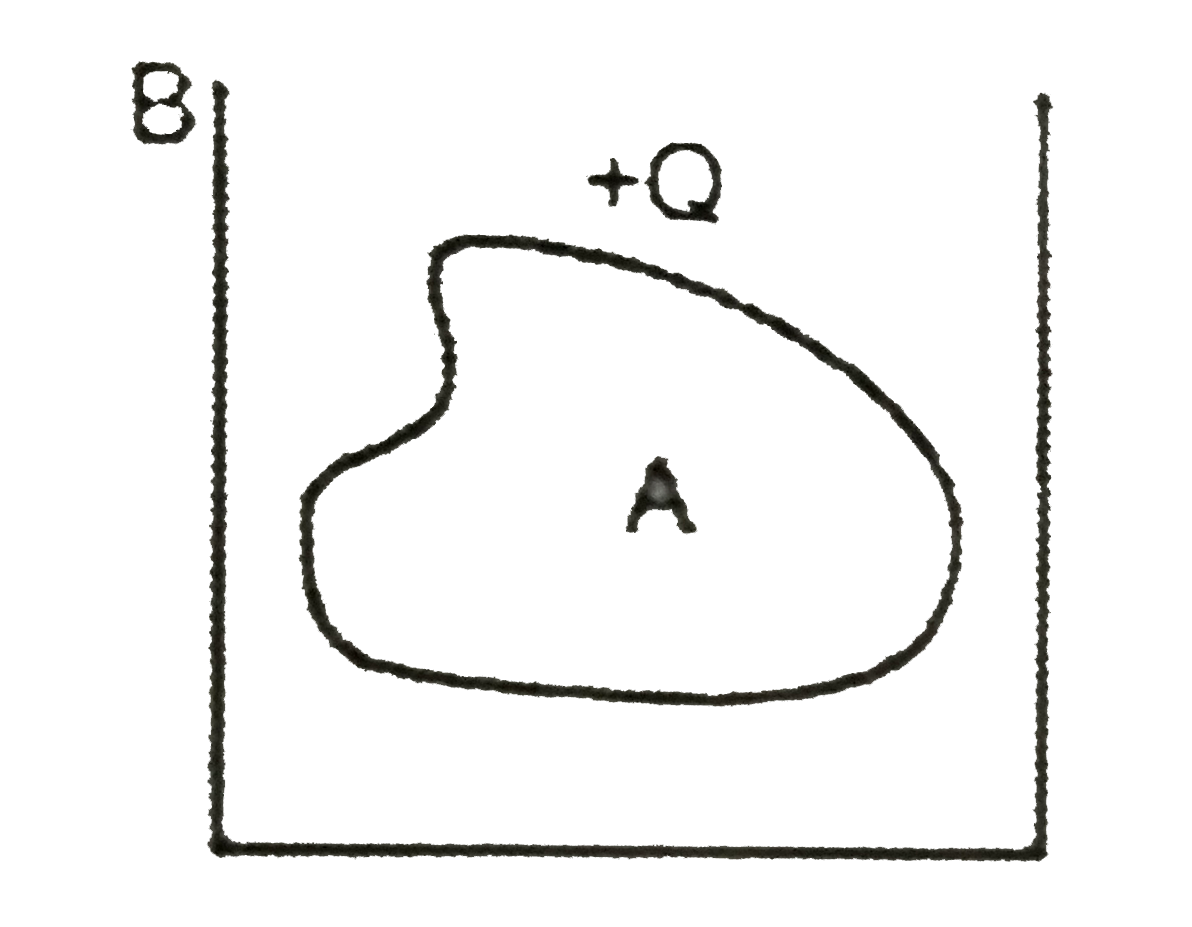
A conductor `A` is given a charge of amount `+Q` and then placed inside a deep metal can `B`, without touching it
View SolutionA conducting sphere of radius `R` and carrying a charge `Q` is joined to an uncharged conducting sphere of radius `2R`. The charge flowing between them will be
View SolutionIn the circuit shown, some potential difference is applied between A and B If C is joined to D
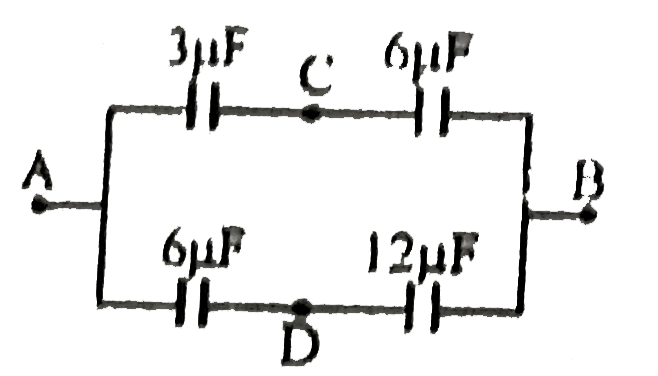
View SolutionIn the circuit shown, the potential difference across the `3muF` capacitor is `V` and the equivalent capacitance between `A` and `B` is `C` Then:
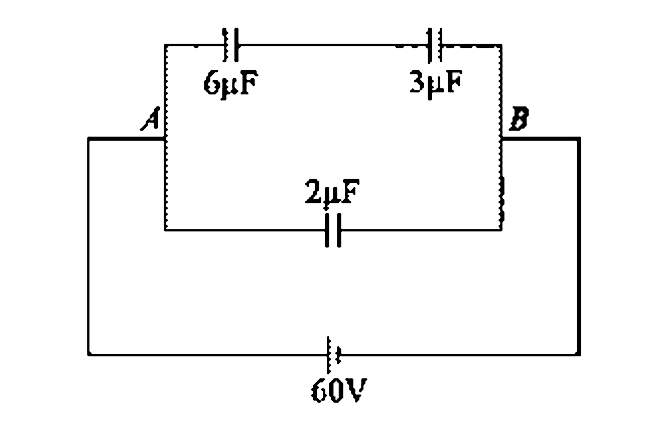
View SolutionThe seperation between the plates of a parallel -plate capacitor is made double while it remains connected to a cell.
View SolutionA parallel-plate capacitor is charged from a cell and then disconnected from the cell. The separation between the plates is now double.
View SolutionIn the circuit shown each capacitor has a capcitance `C`. The emf of the celll is `E`. If the switch `S` is closed then

View SolutionIn a parallel-plate capacitor of plate area `A`, plate separation `d` and charge `Q` the force of attraction between the plates is `F`.
View SolutionThe capacitance of a parallel -plate capacitor is `C_(0)` when the region between the plates has air. This region is now filled with a dielectric slab of dielectric constant `K`. The capacitor is connected to a cell of emf `varepsilon` and the slab is takenout
View SolutionA parallel plate air capacitor of capacitance `C` is connected to a cell of `emF V` and then disconnected from it. A dielectric slab of dielectric constant `K`, which can just fill the air gap of the capacitor, is now inserted in it. Which of the following is incorrect ?
View SolutionA conducting sphere `A` of radius `a` ,with charge `Q` , is placed concentrically inside a conducting shell `B` of radius `b` . `B` is earthed. `C` is the common centre of the `A` and `B`
View SolutionA non conduction ring of radius R Has uniformly distributed positive charge ` Q.A` small part of the ring of length d, is removed (`d ltlt R`) . The electric field at the center of the ring now be .
View SolutionTwo positively charged particles ` X` and `Y` are initially far away from each other and at rest , `X` begins to move towards `Y` with some initial velocity. The total momentum and energy of the system are `p` and `E`.
View SolutionTwo particles `X` and `Y` of equal mass and with unequal positive charges, are free to move and are initially far away from each other. With `Y` at rest,` X` begins to move towards it with initial velocity `u`. After a long time, finally
View SolutionIn a uniform electric field, the potential is ` 10V` at the origin of coordinates , and ` 8 V` at each of the points (1, 0, 0), (0, 1, 0) and (0, 0, 1). The potential at the point (1, 1,1 ) will be .
View SolutionTwo conducting concentric, hollow spheres A and B have radii a and b respectively, with A inside B. Their common potentials is V. A is now given some charge such that its potential becomes zero. The potential of B will now be
View SolutionA positive charge is fixed at the origin of coordinates. An electri dipole which is free to move and rotate is placed on the positive `x`-axis. Its moment is directed away from the origin. The dipole will
View SolutionAn electric dipole is fixed at the origin of coordinates. Its moment is directed in the positive `x`- direction. A positive charge is moved from the point `(r,0)` to the point `(-r,0)` by an external agent. In this process, the work done by the agent is
View SolutionIn a regular polygon of `n` sides, each corner is at a distance `r` from the centre. Identical charges are placed at `(n-1)` corners. At the centre, the intensity is `E` and the potential is `V`. The ratio `V//E` has magnitude
View Solution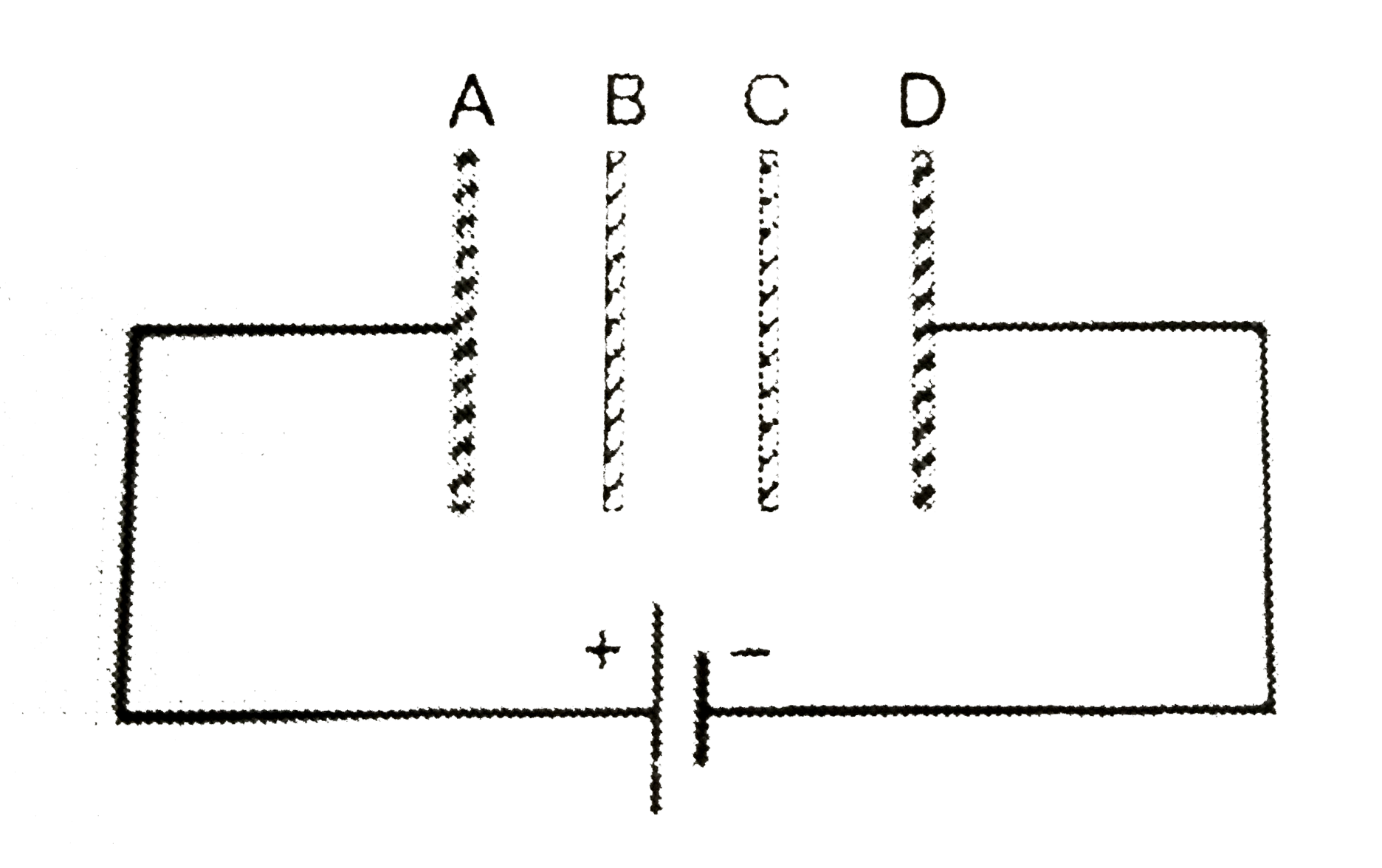
`A,B,C` and `D` are identical, parallel , conducting plates arranged as shown, with equal separations between consecuting plates. `A` and `D` are connected to a cel. If `B` is now connected to `C`, which of the following will occur?
View SolutionA is a nonconducting ring and `B` is a conducting ring. They have the same radius and equal amounts of charge. This is distributed nonuniformly on `A` and uniformly on `B`. `X` and `Y` are points on the axes o `A` and `B` respectively, at equal distances from their centres `X` and `Y` will have
View SolutionA drop of mercury has some charge. If it breaks up into a number of indentifal droplets, the electrostatic energy of the system will
View Solution
All Questions questions and complete solutions for chapter ELECTROSTATICS of D MUKHERJEE PHYSICS (HINGLISH) of Class 12